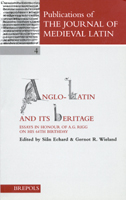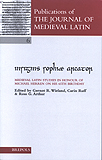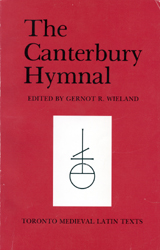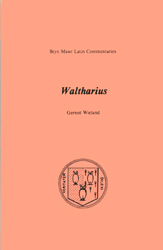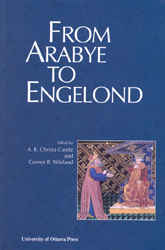Articles and Chapters in Books:
- “Anglo-Saxon Visions of Heaven and Hell,” in Imagining the Medieval Afterlife, ed. Richard Matthew Pollard (Cambridge, 2020), 79-98.
- “Traces of Servius in an Anglo-Saxon Psychomachia Manuscript,” in Studies in Late Antique and Medieval Germanic Glossography and Lexicography in Honour of Patrizia Lendinara, vol. 2, ed. Claudia Di Sciacca, Concetta Giliberto, Carmela Rizzo, and Loredana Teresi (Pisa, 2018), 805-33.
- “Cambridge Songs,” Oxford Bibliographies Online — Medieval Studies, (2017), DOI: 10.1093/OBO/9780195396584-0234
- “Parallel, Tropological, and Fractured Time in Bede’s Commentary on 1 Samuel,” in Le Sens du Temps/The Sense of Time, ed. Pascale Bourgain and Jean-Yves Tilliette (Geneva, 2017), pp. 255-68.
- “Bede and Arator: The (Lack of?) Authority of Poetic Exegesis,” in Auctor et Auctoritas in Latinis Medii Aevi Litteris/Author and Authorship in Medieval Latin Literature, ed. Edoardo d’Angelo and Jan Ziolkowski (Florence: SISMEL, Edizioni del Galluzo, 2014), 1201 – 1213.
- “Legifer, Dux, Scriptor: Moses in Anglo-Saxon Literature,” in Illuminating Moses: A History of Reception from Exodus to the Renaissance, ed. Jane Beal (Leiden and Boston: Brill, 2014), 185 – 209.
- “Bede and Anglo-Saxon ‘Indolence,‘” Mittellateinisches Jahrbuch 48 (2013), 29 – 39.
- “Old English: Language Contact,” English Historical Linguistics: An International Handbook, vol. I. Handbücher zur Sprach- und Kommunikationswissenschaft/Handbooks of linguistics and communication science/Manuels de linguistique et des sciences de communication. Ed. Alexander Bergs and Laurel J. Brinton (Berlin: De Gruyter Mouton, 2012), 362-73.
- “The Unferth Enigma: The þyle between the Hero and the Poet,” Fact and Fiction: From the Middle Ages to Modern Times. Essays Presented to Hans Sauer on the Occasion of his 65th Birthday – Part II, ed. Renate Bauer and Ulrike Krischke (Frankfurt: Peter Lang, 2011), 35 – 46.
- “Bilingual Education in Anglo-Saxon England: Alfred to Aethelweard,” Mehrsprachigkeit im Mittelalter. Kulturelle, literarische, sprachliche und didaktische Konstellationen in europäischer Perspektive. Mit Fallstudien zu den Disticha Catonis. Ed. Michael Baldzuhn and Christine Putzo. (Berlin, New York: de Gruyter, 2011), 35 – 57.
- “A Survey of Latin Manuscripts,” Working with Anglo-Saxon Manuscripts, ed. Gale R. Owen-Crocker (Exeter, 2009), 112-57.
- “A New Look at the Poem ‘Archalis clamare triumuir,’” in Insignis Sophiae Arcator: Medieval Latin Studies in Honour of Michael Herren on His 65th Birthday, ed. Carin Ruff, Ross G.Arthur and Gernot R. Wieland (Turnhout, 2006). 178-192.
- “British Library, Ms. Royal 15.A.v: One Manuscript or Three?”, Beatus Vir: Studies in Early English and Norse Manuscripts in Memory of Phillip Pulsiano, ed. A.N. Doane and Kirsten Wolf (Tempe, 2006), 1-25.
- Bernhard of Angers’s Miracula Sanctae Fidis as Psychomachia,” in Poesia Latina Medieval (Siglos V – XV), ed. Manuel C. Diaz y Diaz and Jose M. Diaz de Bustamante (Florence, 2005), 415 – 424.
- “Assers Vita Aelfredi als Kaiserbiographie?” in Geschichtsdarstellung: Medien – Methoden – Strategien, ed. Vittoria Borso and Christoph Kann (Cologne, 2004), 101 – 115.
- “The Relationship of Latin to Old English Glosses in the Psychomachia of Cotton Cleopatra C viii,” Mittelalterliche volkssprachige Glossen, ed. Rolf Bergmann, Elvira Glaser and Claudine Moulin-Fankhänel (Heidelberg, 2001), 175-88.
- “The Hermeneutic Style of Thiofrid of Echternach,” Anglo-Latin and its Heritage: Essays in Honour of A.G. Rigg on his 64th Birthday, ed. Sian Echard and Gernot R. Wieland (Turnhout, 2001), 27-45.
- “Ge mid wige ge mid wisdome: Alfred’s Double-Edged Sword,” From Arabye to Engelond: Medieval Studies in Honour of Mahmoud Manzalaoui on his 75th Birthday, ed. A. E. Christa Canitz and Gernot R. Wieland (Ottawa, 1999), 217-28.
- “Interpreting the Interpretation: The Polysemy of the Latin Gloss,” The Journal of Medieval Latin 8 (1998), 59 – 71.
- “Gloss and Illustration: Two Means to the Same End?”Anglo-Saxon Manuscripts and their Heritage, ed. Phillip Pulsiano and E. Treharne (Aldershot, 1998), 1 – 20.
- “The Prudentius Manuscript CCCC 223,” Manuscripta 38 (1997 for 1994), 211-27. “Aures Lectoris: Orality and Literacy in Felix’s Vita Sancti Guthlaci,” The Journal of Medieval Latin 7 (1997), 168-77.
- “The Origin and Development of the Anglo-Saxon Psychomachia Illustrations,” Anglo-Saxon England 26 (1997), 169-86.
- “Anglo-Saxon Culture in Bavaria 739-850,” Mediaevalia 17 (1994 for 1991), 177-200.
- “England in the German Legends of Anglo-Saxon Saints,” Words, Texts and Manuscripts: Studies Presented to Helmut Gneuss on the Occasion of his Sixty-Fifth Birthday, ed. Michael Korhammer (Cambridge, 1992), 193-212.
- “Alcuin’s Ambiguous Attitude toward the Classics,” The Journal of Medieval
Latin 2 (1992), 84-95.
- “Manna Mildost: Moses and Beowulf,” Pacific Coast Philology 23 (1988), 86-93.
- “The Anglo-Saxon Manuscripts of Prudentius’s Psychomachia,” Anglo-Saxon England 16 (1987), 213-31.
- “Aldhelm’s De Octo Vitiis Principalibus and Prudentius’ Psychomachia,” Medium Aevum 55 (1986), 85-92.
- “The Glossed Manuscript: Classbook or Library Book?” Anglo-Saxon England 14 (1985), 153-173.
- “Caedmon, the Clean Animal,” The American Benedictine Review 35 (1984), 194-203.
- “Latin Lemma – Latin Gloss: the Stepchild of Glossologists,” Mittellateinisches Jahrbuch 19 (1984), 91-99.
- “Geminus Stilus: Studies in Anglo-Latin Hagiography,” Insular Latin Studies: Papers on Latin Texts and Manuscripts of the British Isles: 550-1066, Papers in Medieval Studies 1, ed. Michael Herren (Toronto, 1981),
113-33.
- with A.G. Rigg, “A Canterbury Classbook of the Mid-Eleventh Century (the ‘Cambridge Songs’ Manuscript),” Anglo-Saxon England 4 (1975), 113-30.
^TOP
Dictionary Entries:
- Hay, Sir Gilbert,” Lexikon des Mittelalters, vol. 4 (1989), p. 1982.
- “Papias,” Dictionary of the Middle Ages (New York, 1987), p. 391.
- “Phoenix,” Lexikon des Mittelalters, vol. 6 (Munich, 1993), c. 2107.
- “Physiologus,” Lexikon des Mittelalters, vol. 6 (Munich, 1993), c. 2121-22.
- “Reimgedicht,” Lexikon des Mittelalters, vol. 7 (Munich, 1995), c. 656.
- “Waldere,” Lexikon des Mittelalters, vol. 8 (Munich, 1997), c. 1957.
- “Wilhelm von Malmesbury,” Lexikon des Mittelalters, vol. 9 (Munich, 1999), c. 173-4.
- “Frithegod,” Medieval England: An Encyclopedia (New York and London, 1998), 307-08.
- “Literary Influences: Carolingian,” Medieval England: An Encyclopedia (New York and London, 1998), 428-30.
- “Prudentius,” Medieval England: An Encyclopedia (New York and London, 1998), 620.
|
 BOOKS | ARTICLES& CHAPTERS IN BOOKS | DICTIONARY ENTRIES
BOOKS | ARTICLES& CHAPTERS IN BOOKS | DICTIONARY ENTRIES